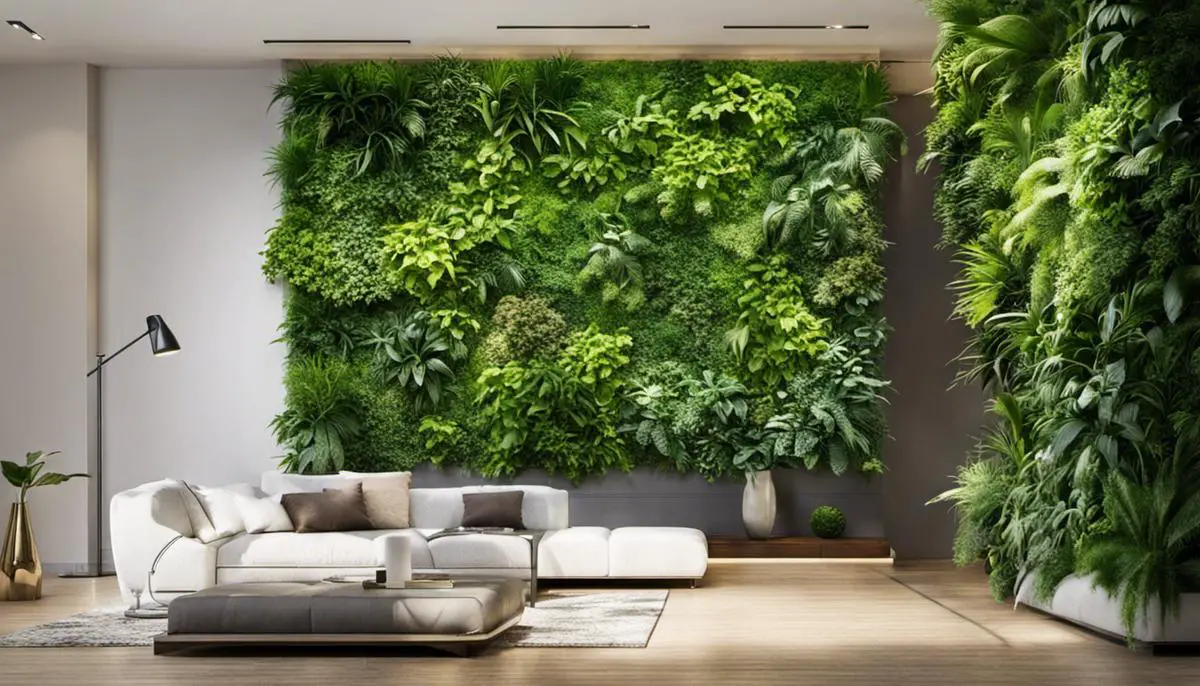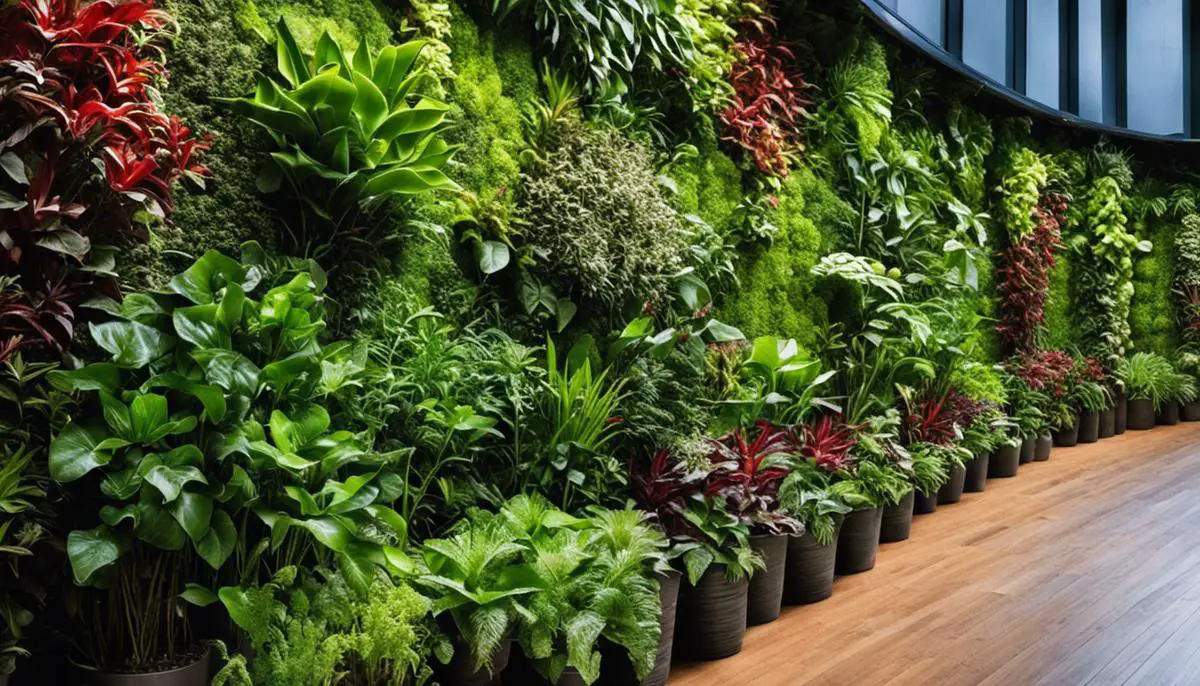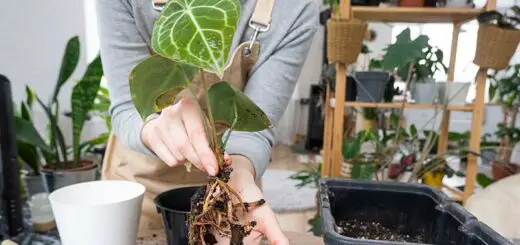Mastering Vertical Gardening with Houseplants
Aspiring vertical gardeners welcome! Vertical gardening with houseplants offers untold benefits, not only in beautifying our indoor spaces but also for our physical and mental well-being. In this insightful discussion, we aim to illuminate the fundamental principles of this trending gardening method, along with a guide on how to select the appropriate houseplants suitable for a vertical environment. This goes far beyond the aesthetics, into a more comprehensive look at environmental factors, growth habits, and maintenance. Moreover, we take the plunge into the nitty-gritty of creating and preserving your indoor vertical garden paradise, providing insightful advice on locating, preparing, planting, and nurturing your vertically oriented green oasis. Lastly, we empower you with the knowledge to mitigate common hiccups faced in vertical gardening, preserving the splendor and vitality of your indoor greenery.
Understanding the Basic Concepts of Vertical Gardening
Understanding Vertical Gardening
Vertical gardening is a gardening method where plants are grown in vertical, stacked layers, typically by attaching them to a wall or a free-standing structure. It allows for the cultivation of a greater number of plants within a smaller space, as it uses the vertical space that would otherwise be left unused. This makes it an effective choice for houseplants, especially in urban living spaces with limited floor or yard space.
The main types of vertical gardening include green walls, which entirely cover a wall with plants and can be used both indoors and outdoors, and trellis gardening, which involves training plants to grow up a lattice-like structure. Vertical garden towers and hanging planters are also popular choices, especially for growing vegetables and herbs at home.
Benefits of Vertical Gardening with Houseplants
Vertical gardening offers many benefits, not only from an aesthetic perspective but also in terms of practical and environmental benefits. Vertical gardens can serve as a unique and eye-catching feature in a home, as well as creating a calming and refreshing atmosphere.
From a practical fashion, vertical gardening can offer a solution for those with limited gardening space. It utilizes the vertical area that many conventional gardening styles ignore, meaning more plants can be grown in a smaller area. This can be vital to people living in apartments or with small yards.
Moreover, vertical gardening has the advantage of reducing the chances of plant pests and diseases. Plants grown vertically have better circulation around them, which reduces the moist conditions that many diseases and pests thrive in.
Environmental benefits include improving the air quality by absorbing pollutants and emissions and providing insulation which can help reduce energy costs by absorbing heat during the summer and providing a layer of insulation during winter.
Basic Principles of Vertical Gardening
Several key principles guide successful vertical gardening. First, understanding the growing needs of your chosen plants is crucial. Choose plants that have similar light, water, and nutritional needs so they can share the same space without competition or stress.
Another principle to bear in mind is the weight of the garden. Structures need to be strong enough to support the weight of soil, plants, and water. Also, consider the maintenance needs of a vertical garden, as watering and fertilizing can be more challenging than with traditional gardens.
Lastly, consider the visual design of the vertical garden for the best aesthetic results. Landscape design principles come into play here, taking into account factors like color, texture, and proportion in the garden’s layout. Varying plant heights and types can also create a more visually interesting garden.
The Practicality of Vertical Gardening with Houseplants
Vertical gardening is not only a practical solution for incorporating houseplants into smaller spaces, such as urban dwellings, but it also utilizes walls and vertical surfaces as creative canvases to display nature’s beauty indoors. The incorporation of a vertical garden enhances the aesthetic aspect of your living space while simultaneously improving indoor air quality.
With the capacity to host a greater variety of plants within a fairly limited area, vertical gardening allows you to curate a colorful, diverse indoor garden. By strategically choosing appropriate houseplants, you can ensure that your vertical garden functions as a natural air purifier and humidity regulator, delivering a more comfortable and healthier living space.

Choosing the Right Houseplants for Vertical Gardening
Fulfilling Environmental Requirements
When selecting houseplants for a vertical garden, it’s crucial to understand the environmental needs of each plant. The indoor climate can vary significantly from plant to plant: while some plants require high humidity, others might prefer dry air. Similarly, the light conditions can dramatically influence the growth of your houseplants; while some demand bright, direct sunlight, others can thrive in low-light environments. Temperature considerations are also vital, as certain plants need cooler settings to flourish. Therefore, understanding and catering to the specific environmental needs of your chosen plants is essential when planning your vertical garden.
Analysing Growth Habits
Consider the way your selected houseplants grow or sprawl. Vine type plants such as Pothos, Ivy, or Philodendrons work well in vertical gardens as they naturally grow downwards. However, bushier plants like ferns or Philodendron Xanadus can also be adapted for vertical gardens. These bushy type plants will need regular pruning to maintain their shape and to avoid overshadowing other plants.
Maintenance Needs
Houseplants for vertical gardening need to have similar maintenance needs. For example, you wouldn’t want to mix a cactus needing little water with a fern needing ample humidity. This would result in one plant easily flooding while the other parches. Therefore, it’s crucial to choose plants with similar watering, fertilizing, and pruning requirements.
Suitable Houseplants for Vertical Gardening
There are many houseplants that adapt well to vertical gardening, providing they are given the right conditions. Snake plants are low-maintenance and flexible in their light requirements. Pothos boasts vibrant green foliage and can survive in various lighting conditions. Peace Lilies would require a shady spot but produce captivating white flowers. Ferns, if placed in a humid space, can provide beautiful texture to your vertical garden. Air plants, in well-ventilated areas, can add a unique look to your vertical garden mix.
Aesthetic Arrangement of Plants
Once you’ve chosen the right houseplants for your vertical garden, you can start to consider their arrangement. A tactic is to place larger, bushier plants at the top of the structure that allows them to cascade over and cover a larger area. In contrast, you might want to place smaller plants towards the bottom so they are not overshadowed. You could also consider arranging the plants in a color gradient, starting with lighter greens at the top and moving to darker shades towards the bottom.
Adapting to Changing Needs
Keep in mind that as your plants grow, their needs might change. It’s important to perform regular maintenance tasks such as watering, pruning, and rotating your plants to ensure consistent exposure to light. Moreover, it’s essential to monitor plant growth and adjust the vertical garden as needed to accommodate changing plant sizes and behaviors.
In conclusion, the secret to mastering vertical gardening with houseplants predominantly lies in the thoughtful selection of plants. One must consider each plant’s specific environmental requirements, growth patterns, and maintenance needs. By making these careful selections, it’s entirely within your grasp to design and maintain a stunning, thriving vertical garden in any indoor space.

Creating and Maintaining a Vertical Garden
Identifying an Ideal Location
Amarjor factor in this endeavor is choosing the correct location for your vertical garden. Spend some time assessing the lighting, temperature, and humidity across various areas of your home before settling on one specific spot. Observing these conditions over a few days can prove insightful, offering an understanding of their patterns. You’ll need to identify a spot where your houseplants can receive adequate sunlight—windows that face east or west are often suitable options. If your home lacks sufficient natural light, consider investing in grow lights. Lastly, ensure the chosen area maintains a temperature that suits your plants, which is usually between 60°F and 75°F, along with a consistent humidity level.
Preparing the Vertical Garden
After selecting your location, you’ll need to prepare your vertical garden structure. This could be anything from wall-mounted planters to standalone shelves or trellises. The goal is to make sure it provides enough space for your plants without overcrowding. Whatever structure you choose should be sturdy enough to support the weight of your plants and their watering requirements. Also, consider a space that’s easy to access for watering and maintenance.
Another important factor to think about is watering solutions, which are crucial for vertical gardening. Drip irrigation systems can be highly effective, but you’ll need to have one set up correctly to prevent overwatering. Additionally, remember to include a subsystem for drainage to avoid root rot and mold growth.
Plant Selection and Care
When it comes to vertical gardening with houseplants, plant selection is critical. Opt for plants that naturally grow upwards, like vines, or those that can be trained to grow vertically like dracaena or pothos. Additionally, consider plant sizes. Larger plants should be at the bottom of the structure to create balance and stability.
Carefully remove the plants from their containers and place them in their allocated spots. Ensure to pot them with suitable soil that accommodates their growth needs. It’s advisable to group plants with similar light, water, and soil requirements together to make maintenance easier.
Cultivating Your Vertical Garden
To transform a vertical garden into a thriving, eye-catching part of your home, consistent maintenance is critical. Begin your day by watering your garden in the early morning, allowing any leftover water to evaporate naturally throughout the day. Keeping an eye out for, and avoiding overwatering is key to dodging potential root rot.
An important element of a thriving vertical garden is the routine trimming and steady stabilizing of your plants, particularly if they start to outstretch their spaces. Periodic pruning encourages denser growth and imparts a neat aesthetic to your garden. To keep those plant pests and diseases at bay, conduct a thorough daily check. Catching any issues early means you can stop them from spreading rampantly through your garden.
In the spirit of beauty and the health of your plants, consider rotating them from time to time. This ensures every plant gets an equal share of light exposure and air circulation, which in turn, furthers their growth. Plus, it gives your vertical garden a dynamic and ever-changing appeal.
Besides these practices, be mindful of your plants’ individual nutrient needs when considering fertilization. As each plant has its own set of nutrient requirements, conduct adequate research and modify your watering and feeding routines to match your plants’ needs.
With focused participation, your efforts will result in a striking vertical garden even within the confines of an urban home. The aesthetic reward of a lush green space at home will be an equal match to the dedication put into nurturing it.

Troubleshooting Common Issues in Vertical Gardening
Spotting Signs of Stress in Your Vertical Garden
When managing a vertical garden, one of the primary steps in addressing potential issues is understanding and identifying the signs of plant stress. These indicators could range from wilting, yellowing, or shedding leaves, to a slowing down in growth, and in severe cases, lead to plant death. Other tell-tale signs could include spotting blemishes or unusual smell permeating the garden. However, not all plant stress can be linked to disease. There are other factors that could cause such symptoms — these could be environmental conditions such as insufficient lighting, overwatering, or substandard soil quality. Becoming adept at recognizing these signs can help you keep your vertical garden in prime health.
Solutions to Common Vertical Gardening Issues
Once you have identified the signs of stress in your houseplants, implementing solutions is the next step. For plants that are receiving insufficient light, try moving your vertical garden closer to a south-facing window or add supplemental lighting. If overwatering is the issue, amend your watering routine, ensuring the soil has a chance to dry out between waterings. Lastly, if your plants are suffering due to poor soil quality, consider adding organic matter or fertilizers to improve nutrient content. The solution often lies in adjusting care rather than drastic measures, emphasizing the importance of understanding and meeting the different needs of your houseplants.
Managing Pests in Vertical Gardens
A common hurdle faced in vertical gardening is the management of pests. These mini-intruders, whether insects, rodents, or birds, can pose a serious threat to the health of houseplants. To manage these pests, regular scrutiny of your plants helps identify an infestation at the earliest. Small insects can be washed away with a steady stream of water, while sticky traps can capture flying pests. Bio-control methods like introducing natural predators of pests can also be highly efficient. In some cases, gardeners may need to resort to pest control products. Always opt for organic options to limit damage to your plants and the wider environment.
Disease Control in Vertical Gardens
Apart from pests, diseases can also hinder the progress of your vertical garden. Fungal diseases are especially prevalent in vertical gardens due to the close proximity of plants. Good air circulation can prevent these types of diseases by keeping the plant surfaces dry, reducing conditions that promote fungus growth. Implementing a routine sanitation protocol, including the regular cleaning of tools and gardening gloves, can prevent the spread of diseases. If a plant does get infected, isolate it from the rest of the garden to prevent further spread and treat with appropriate fungicides or homemade remedies like a baking soda and water mix.
By understanding these common problems and how to handle them, you can better equip yourself to keep your vertical garden thriving. Most importantly, remember that prevention is key. Regular maintenance and observation can prevent most of these issues before they become overwhelming problems. Act promptly on any signs of distress, and most houseplants will return to health with the correct care and conditions.

After fully immersing ourselves in the world of vertical gardening, it is clear to see the immense potential this method presents for houseplant enthusiasts. Not only does it offer an exciting array of design opportunities, but it also provides us with a viable avenue to grow our beloved houseplants in limited space. Armed with the knowledge of selecting the right plants and the basics of establishing your vertical garden, you are poised to start your journey. Moreover, understanding the common challenges and how to overcome them solidifies your path to a successful artistic encounter with nature. Remember, the beauty of a vertical garden lies in its ongoing evolution, providing an ever-changing canvas upon which to express your horticultural creativity. So embark on this unique adventure, keep learning, and allow your vertical garden to keep growing – right alongside you.



